Do hedgehogs make good pets?
It really depends on your preference as the owner. Do you prefer a pet that requires more attention or one that is lower in maintenance?
In my opinion, they are one of the cutest animal anyone can have. Despite their spiky spines, they are actually really nice to hold on to.
But here’s the deal.
Hedgehogs are animals requires lots of bonding and attention in order for them to start feeling calm around you.
Having to snuggle with them probably means you are going to get pricked every now and then too.
So before you buy a hedgehog, you have to read this guide!
Whether you are already an owner of the hedgehog or planning to get one, from this guide, you will be able to learn and understand every aspect in taking care of an African pygmy hedgehog or any other domestic hedgehog as a pet.
You will discover the everyday life of living with a hedgehog which will give you an idea if hedgehogs are really meant for you or not.
Let us begin.
Contents
Hedgehog behavior and temperament
The first thing everyone must know before getting a hedgehog is their behavior and temperament.
Some hedgehog can be grumpy and get scared easily. Every hedgehog has their individual personality and character. So picking the right hedgehog at the start may seem trivial but it is really important.

Understanding hedgehogs characteristics
#1 Hedgehogs are nocturnal.
Hedgehogs can be really active at night. They will run on wheels late into the night so expect sounds from their cages. Playtime will mostly be at night as well. So if you have to sleep early or are a light sleeper, you might want to reconsider having a hedgehog.

#2 Hedgehogs are solitary.
Hedgehogs are solitary animals. They should be kept separate from one another or from any other pet. They do not crave for companionship and might hurt each other when placed together. So it is recommended to house them away from other pets, even their own kind.
#3 Hedgehogs have poor eyesight.
Since they are nocturnal, their eyesight is quite unreliable. They rely mostly on their sense of hearing and smelling to identify and differentiate things.
Hence, you will need to handle your pet barehanded often for them to get used to you. That also means you may get pricked or bitten by them.
If you think you can’t handle them with bare hands then hedgehogs might not be for you.
#4 hedgehog hiss, huff, and curls at things out of fear.
This is one of the most common misconceptions about hedgehogs. Hedgehog will often give out a hissing or huffing sound that might sound aggressive.
They sometimes also harden their backs, curl up into a ball of spikes and jumps at you whenever you try to touch them.
All these signals may give you a wrong impression about them. You might think they do that out of anger but in truth, it is mostly due to fear, nervousness or anxiety.
Hissing and puffing are noises hedgehog make as a deterrence to scare predators away while curling up into a ball of spikes are their defense against strong and large predators.
This is their hereditary defense mechanism that is inbuilt into all hedgehogs. So whenever they are afraid or anxious, they will make hissing noises or spike up.
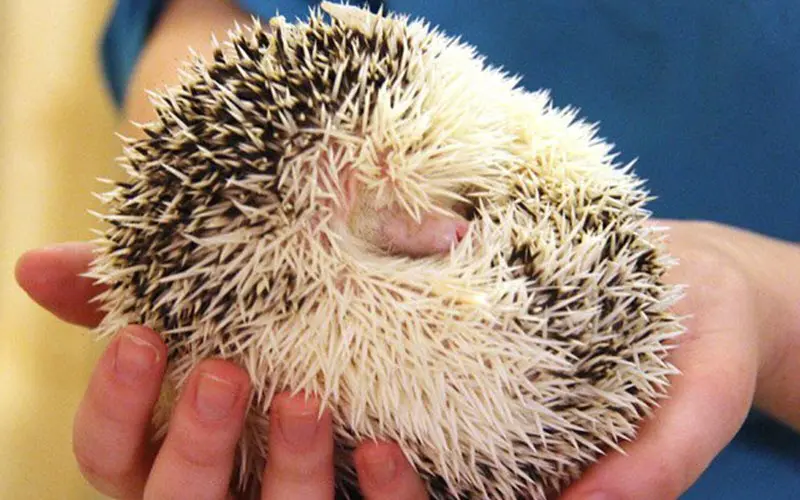
Lots of time are required to bond with them in order to keep their natural defenses down when they are with you. So if you are always busy then hedgehog might not be suitable.
Now, these are just a few prominent characteristics that you must know before you get a hedgehog. If you think this is still the pet for you, let’s move on to the next chapter on handling and taming hedgehogs.
Handling and taming hedgehogs
How to hold a hedgehog?
To handle them, you have to first learn to hold them the right way so that you and your pet will not get hurt.
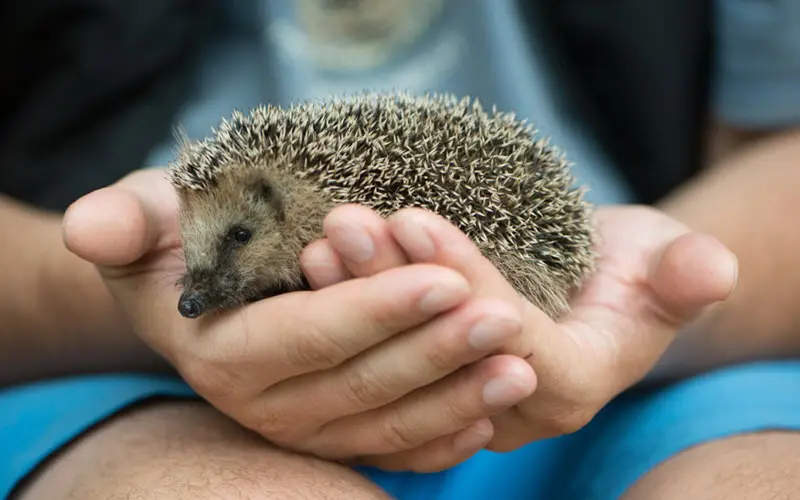
There are 2 methods that I personally prefer. The first way is a common method to pick up hedgehog and the other is picking up hedgehogs when they are curled.
Method 1: Scoop them up on your palms
Hedgehogs are spiky from the top. The only way to pick them up is from underneath them. To do that, place either 1 or both hands from their sides and scoop them up from below.
This method can be done barehanded. It is recommended to start carrying them without gloves or a towel. This is to allow hedgehogs to get used to your scent.
After several attempts, you may find your hedgehog getting used to your touch and scent.
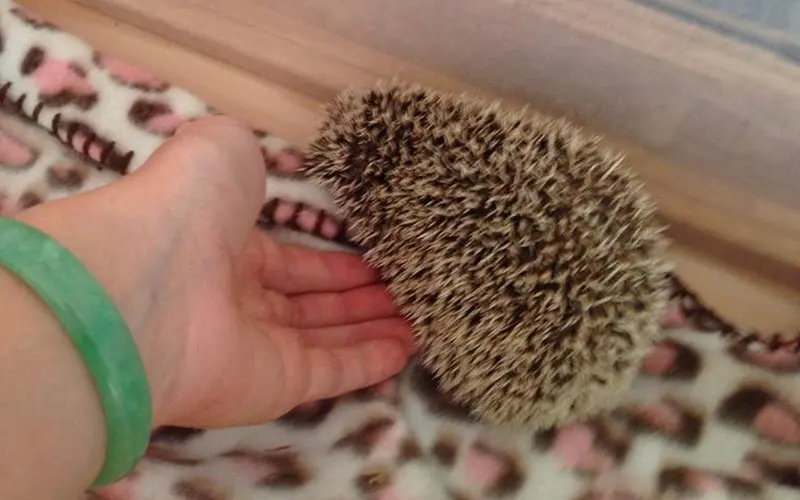
Method 2: Cupping them from the top
The flipping method is primarily for hedgehogs that are curled up. Most of the time it is used when they asleep or sometimes when they are scared.
You can use a fleece blanket or towel with their scent or a scent that they are familiar with to pick them up. This will calm them down a little. It is best to use a fleece towel from their cage.
To do the flipping method, simply place the towel over your palms and gently grab the hedgehog from it’s back. Then flip him over with the palm facing up. You should see a small opening where their head and nose are hidden within.
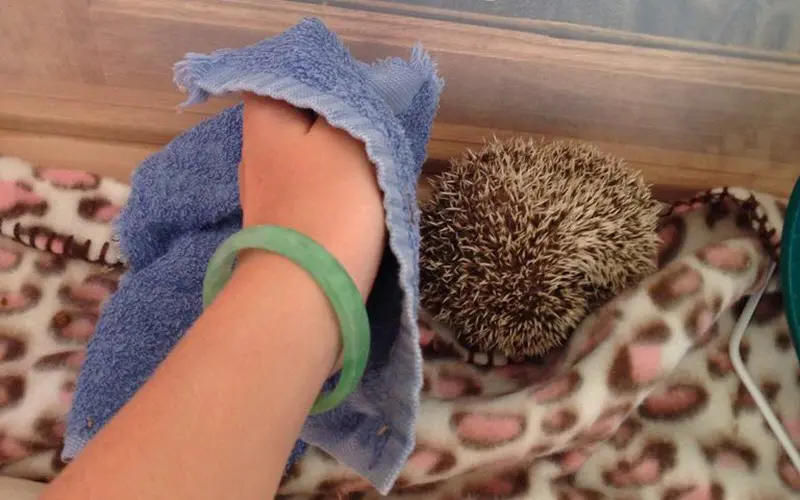
With much practice of these 2 simple methods, you will have no problems carrying them around. See more step by step guide on how to hold a hedgehog here.
Apart from learning to hold them, the next issue you have to tackle is how to uncurl them. Especially if your hedgehog is often anxious, they may curl up often. You have to learn to calm and uncurl them.
How to uncurl a hedgehog?
Hedgehog tends to curl up when they are nervous or afraid. Sometimes they are just grumpy when woken up from their sleep. To have a better relationship with your hedgehog, learning to uncurl them is one crucial aspect.
To uncurl them, you simply have to trigger their curiosity. When they are curious, they will naturally uncurl to see what is going on.
There are 2 ways to do this:
Method 1: Enticing them with food
Using the flipping method, use a pair of angled tweezers from Zoo Med, grab some of their favorite dry food or treats. Then bring it close to their faces and you should see them coming out from underneath their quills to munch off their favorite treats.
Method 2: Piquing their interest and curiosity
Using the scooping method, grab them when they are curled up. You might get poked a little but underneath them is still less prickly.
Once you grab them up place them slowly and gently down on another surface like a tabletop for example. To see where they are going, the only way is to uncurl.
You can also place food at the tabletop to further entice them to uncurl.
So with these 2 methods, you should be able to handle your own hedgehogs when they get anxious. You can find out other methods of uncurling them here.
How to bond and tame your hedgehog?
Bonding and taming your hedgehog is to simply get them to recognize you. As mentioned earlier, they are nocturnal creatures. With poorer eyesight, they make up in hearing and smell.
So to get them to recognize you, work on those senses. We start off by:
Conditioning their sense of hearing
Speak with them often. Always call out to them before, during and after various activities. Activities include feeding time, bath time and playtime. Talk to them every now and then to get them used to your voice.
Conditioning their sense of smell
A few ways to do this:
#1 Old T-shirt method
Grab a t-shirt you wear for 1 or 2 days and throw it into the cage or place them over the cage. You can wrap your t-shirt around them too if you are not afraid they poop over it.
This allows them to get used to your smell really quickly.
#2 Snuggling method
Place them on your lap or chest while you carry on with your activities like watching tv or using the computer. Better still if they fall asleep whilst on your chest or lap.
If you are afraid to go in close contact, in the beginning, place a fleece blanket between your skin and your hedgehogs will help.
There are also many other ways to tame and handle them.
Habitat and housing
If you want to be a hedgehog owner, you definitely must know how to house them comfortably. Understand that some hedgehogs get very anxious in a new environment. So the set up the right home for them is crucial.
Let’s begin looking into what is a suitable home for hedgehogs.
What cage or housing is best for hedgehogs?
Commercial pet cages are one of the top choices for hedgehog owners as they are easy to clean and manage.
Wired ones also provide great ventilation. But if you are going for wired cages always go with those that have a solid enclosed base. Cage with a wired base can be a potential hazard as their tiny feet might get stuck.
See more cage and housing options at our cage setup guide.
Substrate and bedding
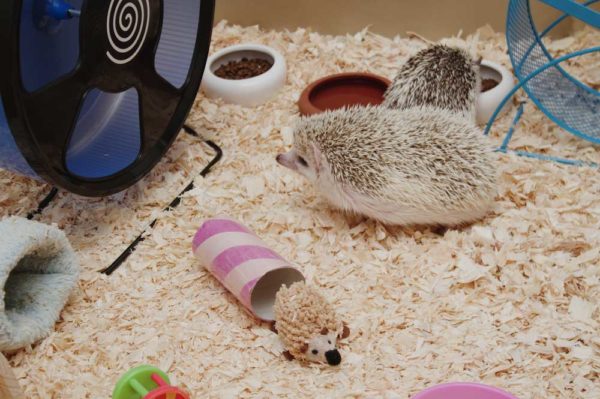
There are many types of substrates that are available. Some examples are:
- Paper shavings
- Wood shavings
- Fabric
Paper shavings

Paper shavings are an effective substrate to reduce the frequency of cleaning and minimize odor from hedgehog waste. However, it is still imperative that you do a full cleanout every 1 to 2 weeks to avoid bacteria buildup in the cage.
Advantages
- A good absorbent of odor
- Less frequent cleaning required
- Easily available
- Cheap
- Allows burrowing
Disadvantages
- Difficult to clean
- Hedgehog may eat bedding which can cause impaction
- Not completely odor-free – cleaning still required
- You can’t really reuse them. You have to change the entire batch every cleanup
If you are going to be using paper shavings, go for something natural and softer. Care Fresh natural paper bedding from Amazon provides exactly that soft texture and are 100% safe for hedgehogs. This bedding is also made of recycled paper and does not generate dust.
Alternatively, you can also go for Kaytee clean and cosy paper shavings, another great odor absorbent bedding that is similar to care fresh but at a lower price.
Wood shavings

Wood shavings are not the most ideal substrate or bedding for hedgehogs as they post potential breathing problems for them. They are, however, are excellent adsorbent for odor.
Advantages
- Very effective at absorbing waste hence reducing odor
- Allows burrowing
- Lesser cleaning frequency as smell won’t be strong
- Easily available
Disadvantages
- Potential respiratory problems
- Not easy to clean
- Have to be replaced weekly. You cannot reuse it for hygiene purpose
- Can cause mites infestation
Even though wood shavings are really great absorbent of odor, they should be avoided unless you know the right brands to use. The only few wood substrate that is recommended by hedgehog owners are the Kaytee soft granule blend bedding that is made from wood fibers and Care Fresh complete natural bedding from Amazon.
Fabric cage liners

Advantages of using fabric types as bedding
- A great option for those who have allergies to wood dust
- Soft and comfortable
- Reusable by washing
- Lower cost since it is reusable
- Lower chances of mites
- Light-colored fabrics allow you to see the color of your hedgehog poop to identify problems
Disadvantages of using fabric types as bedding
- Any loose threads on fabric can entangle up with hedgehogs tiny feet resulting in injuries.
- The fabric must be changed every week
- The fabric absorbs urine and faces but does not reduce the smell
- Hedgehog can’t burrow if you use a fabric base. You will need another fleece blanket on top for them to do that.
Final thoughts on the substrate, it is best to avoid wood substrate altogether. You can use fabric for the main areas of the tank and paper substrate for their litter area.
If you are looking to get fabric bedding, make sure to get one that has a waterproof bottom for easy cleaning. This fabric liner from Amazon is perfect as it comes with a pocket sleeve for your hedgehog to burrow into.
Or you can go for a cheaper alternative such as this warm fleece blanket that is easy to wash and reuse.
Lastly, you can also check out the substrate section in our cage setup guide to get more information on the different bedding types and options.
Water source
Setting up a water source in their cage is important. Hedgehogs need to be kept hydrated especially during the summer season. There are only 2 types of water sources you can consider:
Water bottle

The water bottle is a common way for the hedgehog to self-feed. It is a convenient tool that can be attached to the cage.
Advantages
- Able to easily keep track of water levels
- Top up water less frequently
- More space in a cage
Disadvantages
- Hedgehog can hurt their mouths or teeth when drinking from a bottle
- Some hedgehog might not drink from a bottle.
- Must be checked frequently to see if it is stuck.
For bottles, you should only be looking at no drip, leak-proof ones from Amazon and nothing less.
Water dish
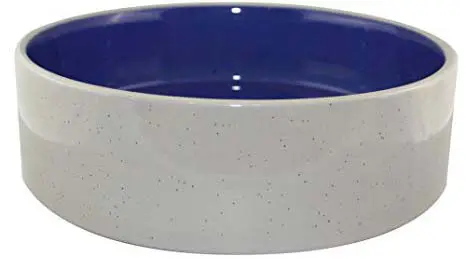
Water dish provides hedgehog easy access to water. Let’s look at some of their pros and cons:
Advantages of using a water dish
- Relatively cheap
- Easy to maintain
- Less of a hazard to their teeth and mouth
Disadvantages of using a water dish
- Water dish doesn’t hold a lot of water, frequent top-ups are required
- Water in the dish if it is not anchored well, can spill or topple. Damp areas in the cage may cause hedgehog to get wet and catch a cold.
- Not easy to monitor how much your hedgehog have drank
If you prefer to use a feeding bowl for water, then it is a good idea to get a bowl with a flat and stable base on Amazon here. Having a lower base will prevent the bowl from toppling and spilling over.
So which is better?
Truth is there isn’t one that is better than the other. It really depends on you or your hedgehog. I personally prefer the water dish as it is easier to use and topping up of water is not a hassle for me.
Before you make that choice, you can either read on or take a look at the water source section in our cage setup guide for more information.
Hedgehog hideouts
Hideouts are where they sleep. It is always good to make it as cozy as you can as they really like to burrow into things that are cozy.
A few good options are:
| Click on images to enlarge | ||
|---|---|---|
 | Fleece Bag or Blanket | See 3 different designs of fleece bags from Amazon. |
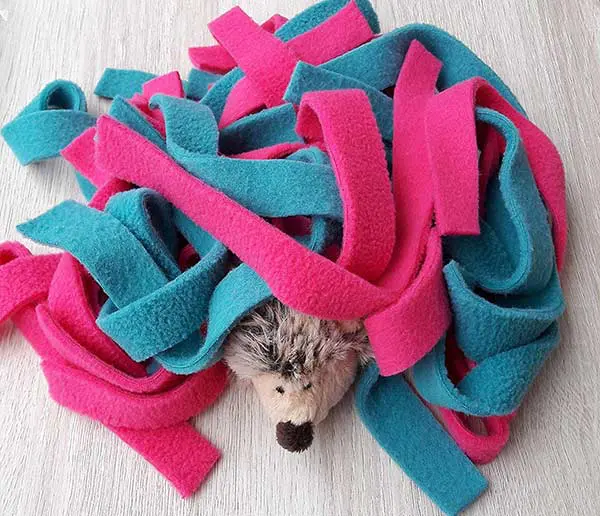 | Fleece Strips | Find a variety of fleece fabric from Amazon. |
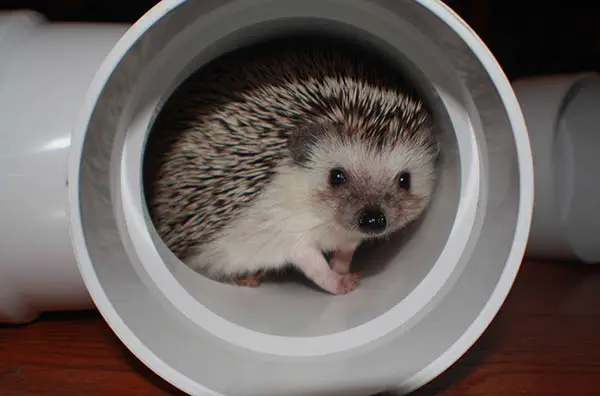 | PVC Pipe | 4 inch PVC pipe tee from Amazon. |
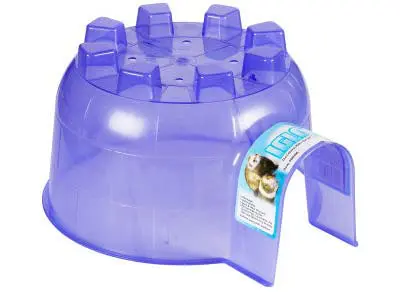 | Igloo House | Cute igloo house from Amazon. |
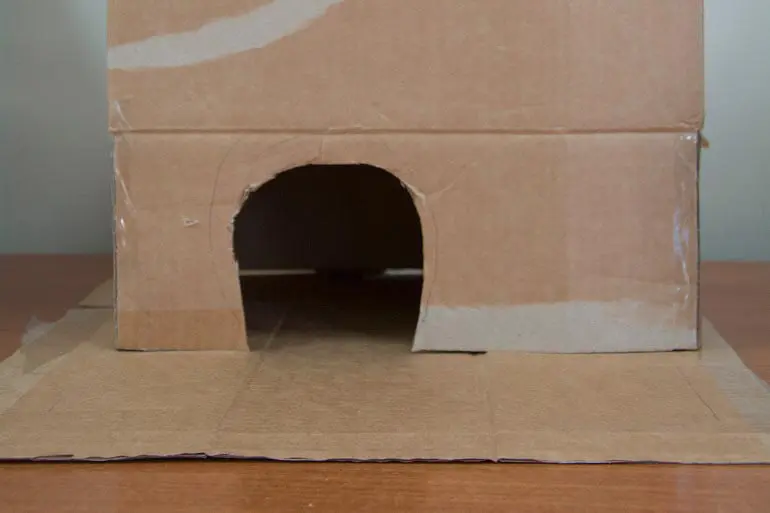 | DIY Cardboard House | Find a full range of premium cardboards from Amazon. |
To see more examples of hideout visit the hideout section in our cage setup guide.
Litter box/area
It is always good to set up an area for your hedgehog to poop and pee. This doesn’t guarantee that they won’t poop elsewhere but it is able to help them get trained.
Here are a few tips when setting it up:
- When setting up their litter box, you can allocate another area with a different substrate if possible. This helps them identify where to pee or poop.
- You can also try picking up their poop and place it in their litter area to condition them to think that is the spot for their nasty business.
To find out more on how to set up their litter area, check out the litter section in our cage setup guide.
Toys
Hedgehogs love to play. Squeeze into narrow cozy space or run about in the dark. So giving them toys is a good way for them to exercise and also have lots of fun.
Running wheels
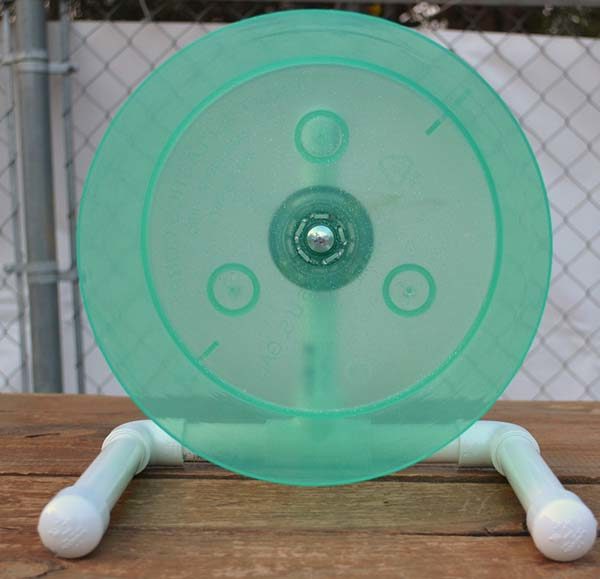
One of the essential toys for hedgehogs are their running wheels.
In the wild, hedgehog travels miles and miles in the dark looking for food. Likewise, for hedgehogs in captivity, they tend to have similar heredity habits of running in the night.
Here are some considerations when it comes to choosing running wheels:
- What is the correct size to get?
- What types of running wheels are there?
- How much do they cost?
The size of running wheels you should go for is at least 11 to 12 inches in diameter and about 5 to 6 inches in running width to prevent them from tripping and falling.
Types of running wheels
To see more options of running wheels check out the running wheel sections under our hedgehog cage setup guide.
Dig boxes

Dig boxes are a great toy for the hedgehog to forage for treats. This gives them opportunities to have fun while exercising.
You can create your own dig boxes easily with cardboard or purchase them online at a relatively cheap price.
Here are some examples from Amazon:
- Litter box for cats can be used as hedgehog dig box
- If you prefer a dig box that is lower, you can also try this litter pan dogs.
- Or you can simply use a foldable container like this.
Toilet paper rolls

Toilet paper rolls are a great and cheap alternative toy for the hedgehog. They love burrowing into toilet paper roll.
Do take note that sometimes hedgehogs can get their heads stuck in toilet rolls and start going frantic.
So it is best to keep them under supervision when they are playing with toilet rolls.
Alternatively, if you plan to leave the tube in the cage, always cut down the sides to loosen up the toilet rolls.
Here are just of the common toys that are for hedgehogs. To find out other alternatives, just check out our toys section under the cage setup guide.
Hedgehog food and diet
Feeding hedgehog can be pretty tricky as their diet can affect their health greatly. If you want your pet hedgehog to live a long life, you definitely have to make sure they are having the right amounts of nutrients.
Anything too much will result in obesity, liver and kidney failure. Anything too little will result in being underweight and malnutrition.
What can your hedgehog eat?
Let’s look at some examples of food that are suitable for hedgehogs:
Dry Food
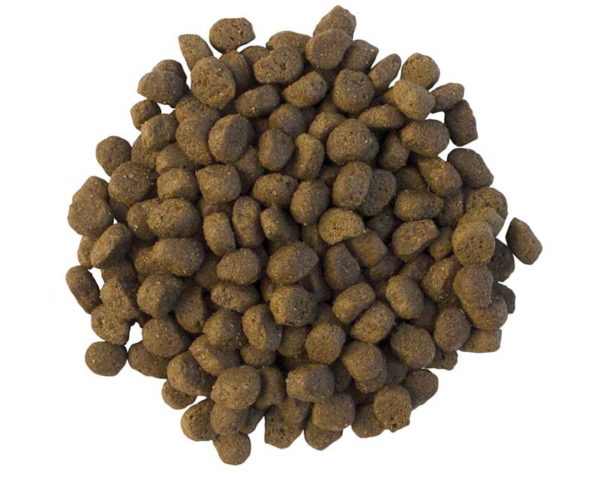
Dry food is a good main staple for hedgehogs. They are easily available online or at pet stores. Many also claimed that dry food help keep hedgehog gums and teeth healthy too.
For dry food, it is much easier to determine the right levels of nutrients as they have labels that provide that information.
So before you buy any dry food, always check the labels for their content and nutrients level.
The ideal nutrients level for a juvenile or adult hedgehogs that you want to watch out for are:
- Protein: 30% – 33%
- Fat: 10% – 13%
- Fiber: 3% – 8%
Protein above 35% can be considered high for hedgehogs. It can stress out a hedgehog’s kidneys in the long run.
Fat levels above 15% are also on the high side that can lead to obesity and fatty liver. Unless you hedgehog is underweight, you should never food with fat levels higher than 15%.
Here are some examples of dry food:
Soft Food
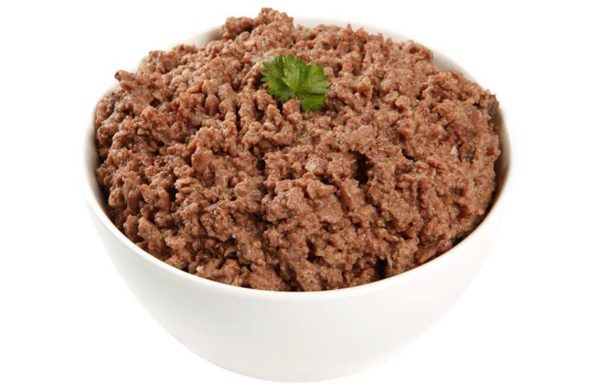
Soft food or wet food can also be a delicious treat for your hedgehogs. They are also easier to digest and are great for aged hedgehogs or those with gum and teeth problems.
But here’s the deal.
Most of them are really high in protein and fat because of the moisture (gravy) that are present in them.
So the nutrients on the labels of the wet food do not accurately tell you the exact amount of fats and proteins you are getting. To get the right figures you have to calculate it with DMB percentages.
DMB also was known as Dry matter basis is a calculation of nutrients without considering the moisture within. So in other words, to get the actual fats or protein levels, you will have to calculate the fats and protein levels of the moisture and add them together.
To calculate nutrients levels for wet food accurately, head over to the DMB calculation section in our full hedgehog diet guide here.
That said, this does not mean that soft or wet food is not good. What you can do is to mix them with dry foods or just feed them moderately as treats.
Examples of suitable wet or soft food for hedgehogs:
Fruits and vegetables
Fruits and vegetables are one of the food types that are more controversial. Many are not sure if hedgehogs are able to ingest greens.
The fact is hedgehogs are considered omnivores and can have vegetables or fruits as part of their diet.
So Yes hedgehog can eat the following fruits and vegetables:
- Apples
- Bananas
- All berries like strawberries, blueberries, blackberries, cranberries can be fed to hedgehogs except grapes. Do Not feed them Grapes! (see foods to avoid section)
- Pear
- Plum
- Cherries
- Melons such as watermelon, honeydew but they are high in sugar. Take in moderation.
Cucumber and lettuce but they hold little nutrients and are mostly made up of water - Leafy greens
- Sweet potato
- Green beans
- Zucchini
- Spinach
- Broccoli
- Asparagus
- Dandelion greens
- Bell peppers
- Cooked carrots (raw ones are too hard for hedgehogs)
Live Food
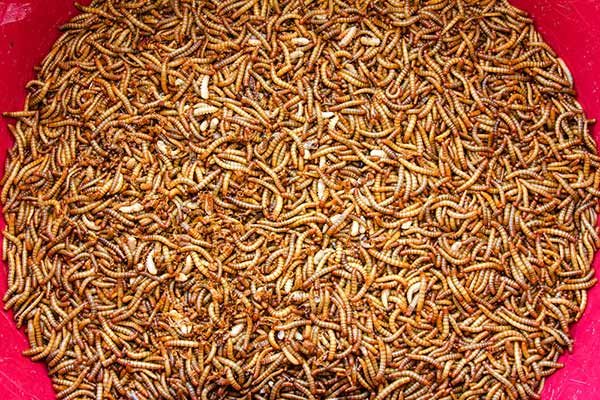
Live food such as insects is one of the hedgehogs favorite food. After all, they practically feast on insects in the wild. This is also what makes them so desirable – a pest killer!
But unlike wild hedgehogs, hedgehog in captivity do not hibernate. They do not need a high-fat diet like insects as their main source of diet.
Insects are indeed delicious delicacies for hedgehogs but are also definitely high in fats. So if you do not want an obese hedgehog, it is best to keep insects diet in check.
You can, however, use live insects as treats for the hedgehog. This allows you to keep in check how much they have taken.
Let’s take a look at some suitable insects for hedgehogs:
- Mealworms
- Crickets
- Waxworm
- Nightcrawler
- Silkworms
- Phoenix Worms (Black soldier fly larvae)
- Hornworms
- Maggots
- Superworms
Other Treats
There are also many other treats that you can feed your hedgehog with. Indulge your hedgehog once a while on treats is definitely good to make them happy. But feeding them often with treats can result in serious obesity.
Here is a list of treats that are suitable for hedgehogs:
- Cooked unseasoned meat
- Cooked unseasoned egg
- Baby food
- Applesauce or peanut butter
Foods that you MUST AVOID
If you are going to be a hedgehog owner, you must know this. There are several foods that you must avoid feeding your pet at all cost. They can lead to serious problems in the short and long term.
- Grapes and raisins
- Garlic, Onions or Chives
- Fruits or veggies that have citrus or are too acidic
- Orange
- Lemon
- Lime
- Grapefruit
- Tomatoes
- Pineapples
- Milk and Dairy
- Salty or food with seasoning
- Chocolate, Coffee, and Caffeine
- Tea Tree oil
- Raw food – poultry, eggs etc
How much should you feed your hedgehogs?
As a pet owner, you definitely need to know how much can a hedgehog eat. This could also an area to look at for recurring cost.
But the good news is that hedgehogs are generally small so they do not consume large quantities compared to many other pets.
During each meal, you can probably feed them about 60 to 70 pieces of kibbles as main staple or 1 to 2 tablespoons of wet food as part of a mix.
If you are using dry food as their main staple (which is recommended), a bag of 3 lbs kibbles can probably last you about 2 to 3 months.
So the total cost can be between $15USD to $20USD depending on the brand and where you buy them from.
Some owners prefer to buy bigger bags for better savings but I don’t recommend you do that because the food will turn bad within weeks upon opening..
Then you are probably wondering, isn’t the expiry date usually about a 1 year period? Well, that is only applicable if you leave it sealed. Accordingly to pet food formula expert Steve Brown, pet food can turn bad in 2 weeks from the exposure of oxygen and humidity.
This is why it can be a good idea to purchase smaller packets of dry food but in more quantities to store them so that they don’t run out.
How to feed your hedgehogs?
To feed your hedgehog, you must first know how to prepare their meals. This brings us to the Hedgehog diet mix where you mix different types of food to provide them with a complete balanced diet.
Mixing your hedgehog diet
It is important to first introduce kibbles as their main staple before mixing other foods. This is because hedgehog can be picky when it comes to what you feed them with.
Once they get used to a particular food they like it can be difficult to change it hence, always feed them with dry kibbles first before anything else!
As they start to get used to kibbles, you can begin to add other mixes of food such as wet foods, treats or live insects.
Mixing up food, on one hand, allows them to also get used to other new food types and on the other, give them proper nutrients to stay strong and healthy.
There are 3 common ways to feed them.
- Scheduled feeding
- Free feeding
- Syringe feeding
Schedule feeding allows you more control over how much your pet hedgehog eats because you will feed them at certain timings. The downside is that you might need to stay up later since hedgehogs are active mostly only at night.
Free feeding, on the other hand, allows your hedgehog to eat on their own as and when they feel like it. It will be more difficult to keep track of their diet as you have to count the leftovers to keep tracking of how much they ate.
It is not advisable to allow free feeding for obese hedgehogs or for those who tend to run less.
Lastly, syringe feeding is meant for hedgehogs with gums or teeth problems. Older hedgehog might also require syringe feeding.
In some cases of illness, hedgehogs might stop eating. In such cases, syringe feeding will be an ideal method to feed them to get the nutrients they require.
To learn how to syringe feed, check out the syringe feeding section of our diet guide. Or if you need syringes, you can find a list of cheap syringe here.
To wrap up on this chapter, what you see here is just the tip of an iceberg. Taking care of the hedgehog’s diet requires more attention, effort, and commitment.
At this point in time, if you are still serious about having them as a pet, feel free to hop on to another blog on Hedgehog diet guide where you will find a comprehensive step by step on how to feed hedgehogs, their feeding frequency and much more.
Otherwise, let’s move on to the next section on…
Illness and symptoms
Knowing when your hedgehog is ill is an important part of taking care of your pet. Here, I will run through some of the common illness and symptoms and what to do about it.
Let’s begin
External parasites
There are a few kinds of external parasites. They include ticks, fleas and also microscopic mites. They are usually a nuisance that will cause terrible itch and scratching on your hedgehogs.
Here are how you can identify them:
Ticks
Ticks are pretty common if your pet often spends much of their time outdoors. They are usually found in wooded grassy areas and will attach on to their host to begin feeding off their blood.
Ticks on hedgehogs are usually not life-threatening and are not something that you should panic over.
When ticks feed till they are full, they will fall off so 1 or 2 ticks would not cause much of an issue. However, in large numbers, they do post a serious threat to your hedgehog. They should be removed quickly to prevent breeding.
Symptoms of tick infestation
You will notice greyish or white round blobs that are attached to their spines, fur, around the face and ears.
Treatments for ticks
It is not easy to remove them as their grip is very strong. Removing them forcefully can create lots of pain in your hedgehog.
To remove them a special tool like a hook or tick tweezers are required. These tools are able to effectively remove the entire tick from the skin. Do not attempt to do it yourself if you are unsure.
You have to remove the entire tick including their head. If you accidentally pulled the tick out leaving the head on the skin, it causes other more serious infection. I will recommend seeking professional help from a vet.
But if you are confident and would like to attempt this on your own, you can get a tick twister removal tool here.
Fleas
Fleas are a lot more annoying compared to ticks. After all, they are tiny and are really very difficult to get rid of.
Similar to ticks, they are usually contracted outdoors but in places that are shadier. This includes decks, porches or places like under the bushes or areas with vegetation.
Accordingly to fleascience.com, fleas do not transfer from host to host often, especially cross-species. So if your hedgehog has gotten fleas they most likely do not transfer to your dogs and cats. But it is still always good to keep your pets separated.
Symptoms of flea infestation
You will notice red or black tiny insects that jump on your hedgehogs. They can cause a severe itch that often leaves hedgehogs scratching themselves. They sometimes can also cause a rash on hedgehogs.
Treatment for fleas
Do not use the common flea treatment sprays or powder that you usually use for your dogs and cats as they might result in respiratory issues in your hedgehog. It is better to visit a professional vet to get advice on which spray to use.
Mites or mange disease
Mites are one of the worst external parasites that cause mange, a skin disease in hedgehogs. They can leave behind serious damage to your hedgehog skin, hair and looks. And the worst part, mange infection can take several weeks to a month or more to see recovery.
Apart from that, they are highly contagious that could easily spread to you or your other pets! Hence, it is very important to identify their symptoms and treat them early.
How does hedgehog get mites?
This is probably the first question many will ask. Mites are microscopic species that are commonly contracted from another animal, from the food they eat or from their bedding.
There is really no way of telling exactly where it comes from as they are too small to be seen. Even when visiting a vet, a skin scrape and a microscope view is required to confirm if it is mites infestation.
Symptoms of mites or mange disease
- Losing hair or quills – patchy red areas start to appear
- Scratching or biting themselves
- Weight loss and tiredness can be seen
- Dry and flaky skin
- Redness or rashing
Symptoms are usually very obvious even though you can see mites. Once the symptoms start to show, it is very important to wear gloves when handling them. It is also crucial to keep an eye out on your other pets that your hedgehog has come across with.
Treatment for mites or mange disease
Do not attempt to treat mites on your own. It is best to visit a professional vet. Generally, the vet will perform a skin scrape to diagnose if it is mites. They will also prescribe drugs such as ivermectin and selamectin to treat mange disease.
After seeing a vet or confirming it to be mites, it is imperative that you clean out your entire hedgehog cage, change bedding and substrates, clean out food bowls, toys, and wheels with mild detergent.
Lastly, also make sure to put remaining food into the freezer to kill off any mites.
Prevention is better than cure
To prevent mites, it is always important to wash your hands after handling pets from stores or in the outdoors.
If you bought a new pet or hedgehog, quarantine them for a week to watch out for symptoms. And always refrigerate your food once they are unsealed.
Ringworm infection
The next terrible external parasite any hedgehog can get afflicted with is ringworm infection. Despite its name, it is actually not caused by worms. Rather, they are caused by fungus.
Hedgehogs can carry them without showing any signs of symptoms. But upon the stress of captivity or other illnesses, they can be triggered and developed.
There have also been reports of hedgehogs that seems to be adapting fine in captivity but later develop ringworm suddenly.
Do note that ringworm infection is also highly contagious and can be passed on to humans or other animals. So it is important to keep up with hygiene practices and wear gloves when handling them.
Symptoms of ringworm infection
- Spine or hair loss – hedgehog lose hair or spines at affected areas
- Crusty or flaky skin on the face, head or ears
- Scrabs and scurfs may appear along their spine or hair
- Weight loss and tiredness can be seen
- Skin irritation and itching
- Redness or rashing
Treatment for ringworm infection
I will never recommend you to treat them on your own unless you are really confident. Always seek professional help
Warm almond oil is usually administered on affected areas to soften their spines and fur to expose the affected areas. An antifungal solution like Imaverol will then be mixed into warm water to bathe your hedgehog in.
According to hedgehog-rescue.org.uk, an antifungal bath should be done 4 times every 3 to 4 days. On days that they are not bathing, Neem Oil or Thursday Plantation Antiseptic Tea Tree Cream can be used on affected areas. Do take note Never to use Tea tree oil.
Lastly, wipe down everything your pet has come into contact with a mild detergent to avoid this nasty fungus from spreading to your or your other pets.
Gastrointestinal and Hepatic Diseases
Gastrointestinal (GI) obstructions or impaction
Gastrointestinal (GI) obstructions or impaction is very common among smaller pet. Hedgehogs are also victims to such dangers.
Impaction or GI obstruction can be or are commonly caused by ingestion of things like rubber, carpet fibers or even substrates and sometimes also the food diet they eat.
Hedgehog love to nibble away at little things, which is why, apart from their food, items that are small enough to be ingested should be cleared away in their cage.
Symptoms of GI obstruction can be but not limited to:
- Loss in appetite. Stopped eating.
- Hedgehog starts looking lethargic when he or she was once very active.
- Vomiting
- Acute abdominal pain which can be noticed if they start hissing and grumbling more.
Treatment and diagnosis
There are really no remedies for this. Seek treatment from a vet immediately if suspected of impaction or GI obstructions.
X-rays will be taken to ensure there is no misdiagnosis. In the worse case, an operation may be required.
Diarrhea
Diarrhea is an important sign of something serious in the making. Or it could just be due to something temporary like a change in the environment.
No matter what, diarrhea must be treated early and properly as it can lead to dehydration or even death.
Here are some common causes of diarrhea, how to diagnosis and treat them early:
Internal parasite: gastrointestinal infection by Salmonella or other bacteria
Hedgehog can also be picked up bacteria such as salmonella from their feces or when playing outdoors.
Symptoms of gastrointestinal infection:
- Diarrhea
- Weight loss
- Loss of appetite
- Dehydration
- Lethargic hedgehog
- Change in diet or environment
- Change in hedgehog environment can cause them to become nervous resulting in diarrhea. So is changing their diet.
What they eat is really important as you want to avoid certain food such as milk. Take a look at a full list of food that is suitable for a hedgehog and what to avoid here.
Diagnosis and treatment for diarrhea
First, understand the cause of diarrhea to avoid misdiagnosis.
If diarrhea started after a change in diet, stop new diet immediately and begin fluid therapy to hydrate them. Sometimes syringe or force-feeding may be required.
Check out a list of food you definitely want to avoid for hedgehogs.
If it is just a change in environment, start fluid therapy to hydrate your hedgehog. Make sure they are kept in a calm and cozy environment with the right temperature and monitor them closely.
See handling and calming guide here.
After which, try feeding them in the next feeding cycle to see if they start eating.
If it is due to internal parasites such as worms or bacteria, they will usually come with other symptoms.
Such symptoms include:
- Loss in appetite. Stopped eating.
- Hedgehog starts looking lethargic when he or she was once very active.
- Green/yellow watery poop
No matter what reason, if diarrhea persists for more than 24 hours take them to a vet immediately.
A vet may run a test on hedgehog fecal matter or bacteria culture to find out the source of the problem. This means that your hedgehog might be anesthetized to go through certain procedures.
Respiratory problems
Common respiratory problems in hedgehog cause by simple upper and lower respiratory tract infection to serious cases of pneumonia. This happens when the infection spreads to their lungs.
Signs and symptoms of the respiratory problem:
- Sneezing and nasal discharge
- Increased respiratory noise
Signs and symptoms of pneumonia:
- Dyspnea or shortness of breath
- Lethargy and weakness
- No appetite
- Even sudden death
Once you see hedgehog movements slowing down with signs of lethargy and are accompanied by sneezing or shortness of breath, take them to a vet immediately.
Treatments for respiratory infection
A vet will usually prescribe antibiotics. Hedgehogs with respiratory problems are generally lethargic and will not be eating. So fluid therapy and force-feeding may be needed.
A hedgehog that is infected should also be isolated with no contact with other pets.
As they say, “Prevention is better than cure”!
Always keep your hedgehog cage and environment clean. Give them a good bathe every 2 to 3 weeks to keep them clean and bacteria free.
Oral and Dental Diseases
Another common issue you may face as a hedgehog owner is oral and dental diseases. The common dental diseases include Tartar, Calculus, and plaque.
The symptoms are these diseases can be seen on hedgehog gums. If there are black or brown stuff on their teeth, they might be having dental issues.
Such dental problem arises after a long time of not cleaning or brushing your hedgies teeth. Over time their saliva, leftover food, and bacteria mixed together to form plaque.
These bacteria on the gums can then enter from the gum line into the bloodstream that can then continue to travel into their major organs.
Once plaque tartar or calculus forms, they are really hard to get rid without professional help.
Diagnosis and Treatment
Hedgehog will be required to be put under anesthesia to go through X-rays, cleaning, and polishing. Should there be any teeth causing problems, they can be removed as well.
Prevention
Regular brushing goes a long way. Doing that will help to reduce dental problems in the long run.
To brush their teeth, do not use toothpaste but just a simple Q-tip and gently brush through the side of the teeth.
If some bleeding occurs, it is really normal and you should not panic.
Rinse them off with a little bit of water and carry on.
Cancer
Just like any animals, there are different types of cancers that can affect a hedgehog’s wellbeing.
Common cancer for hedgehog includes:
- Mammary gland tumors – Tumor in the abdominal area
- Reproductive tract cancers – uterine or ovarian tumors
- Oral Cancers
- Lymphoma that affects lymph nodes
Symptoms for cancer can vary depending on the area that is affected. Sometimes they may not show any clear signs too.
Some common symptoms include:
- Loss of appetite is not showing signs of recovery.
- Increased effort to breathe – labored breathing
- Lethargy and weakness
- Weight loss
- Diarrhea
- Tumor growth
Note that these symptoms are easily misdiagnosed as they are very similar symptoms to many other illnesses.
Diagnosis and Treatment
If symptoms are persistent, take them to a vet quickly. Similar to humans, the chances of recovery are higher during the early stages of cancer.
Cancer is usually only determined after a biopsy to avoid misdiagnosis. Some tissues from your hedgehog will be removed for examination.
As for treatment, it may include the removal of affected cells through surgical procedures. Radiation and chemotherapy are also some of the next options in line.
Neurological disorder: Wobbly Hedgehog Syndrome
Wobbly hedgehog syndrome (WHS) is a type of progressive degenerative neural disorder in hedgehogs that affects their muscle control.
It is will slowly cause paralysis starting from their tail and progress forward till they are not able to walk or move.
This disorder is genetic and there is nothing to prevent it. But there are signs for early detection from the way they walk.
Symptoms:
- Wobble when the hedgehog is trying to stand still
- Fall over frequently while walking
Symptoms will usually show after 2 to 3 years of age but sometimes, younger and older or older hedgehogs can get afflicted by this disorder.
With that in mind, walking issues can also be caused by low temperature in their environment resulting in triggering their hibernation instincts.
If the results are the same even after warming up their environment, there is a high chance it can be WHS.
Sadly, just as there is no prevention to WHS, there is also no cure at the moment. The only thing you can do is to provide care to them in the best way possible.
That include keeping your hedgehogs upright with towels, hand feeding them and cleaning them if they get soiled.
Among these illnesses and diseases, most of the common ones are generally preventable by good hygiene practices. This brings us to the next section on bathing your hedgehog.
Bathing and grooming
Bathing a hedgehog is one of the most enjoyable activities you can do for them as pets. It is also a great time to bond with them.
During activities like bathing, talk to them often to get them used to your voice. This will associate your voice with their favorite activities.
Steps to bathe your hedgehog:
To begin a nice warm bath, here is what you will need:
- Shampoo – You can use Kaytee tearless pH balanced shampoo that is safe for small pets
- Warm water
- Soft toothbrush
- Anti-slip bath mat
- Hair dryer
Step 1: Clean up your sink or bathtub.
Step 2: Place an anti-slip bath mat at the bottom of the sink or bathtub.
Step 3: Fill up a sink or tub with warm water. Always feel the temperature to make sure it is not scalding hot
Step 4: Gently place your hedgehog into the tub. Watch them curl up and float on the surface.
Step 5: Wait for them to slowly uncurl their spine as they get used to their environment. Some nervous hedgehog may also pee and poop into the water.
Step 6: Squeeze and rub shampoo on your palms to create foam. Then gently apply along with your hedgehog quills. Avoid their face at all cost.
Step 7: Use the soft toothbrush to gently scrub their hands and feet to get rid of any dried up poop.
Step 8: Drain water from the sink and gently pour remaining warm water over them. Once again avoid their face.
Step 9: Get them out of the sink and place them in a towel and gently dry them up.
Step 10: Use your hair dryer at the lowest setting to gently blow on them.
Grooming your hedgehog during or after baths
Once they are relaxed after or during a bath, it is the best time to trim and cut their nails.
Depending on your hedgehog, some don’t require to cut their nails that often as they will wear down their nails when they are playing. But you will still have to do this every few weeks.
Here are some points to note while cutting their nails:
- Always use a pet nail clipper or baby nail clippers and not anything too big
- They may fidget a lot so some force is required.
- You may also need someone else to hold them down as you hold out their hands and feet.
- Do not attempt to cut too deep or you may cut into their quick. Just cut part of their nails away.
- If you do cut into their quick by accident, do not panic. Just apply some styptic powder for pets on them. It can hurt as you apply styptic powder but it is necessary to prevent infections.
How much does a hedgehog cost?
Now that you have seen most of the responsibilities involved in taking care of a hedgehog and still would like to go ahead to get one, then you will need to know every costing of having a hedgehog as a pet.
The exact cost can vary depending on their type, color, and breed. Your monthly running cost can also change from time to time depending on their lifestyle and diet.
Let’s take a good look at every cost involved in having a hedgehog as pet
Cost of buying an African pygmy hedgehog can be as low as $70 to as high as $300.
According to hedgehogcare101.com, different breeds or color fetch different prices.
Here are the different color and their prices starting from the rarest:
- Black african pygmy – $300 and above
- Albino african pygmy (red eyes) – $300 and above
- White african pygmy – $275 and above
- “Snowflake” or african pygmy with white quills – $275 and above
- Algerian or North african hedgehogs – $250 and above
- Pinto (mix with patches of black and white) – $225 and above
- Champagne blonde african pygmy – $225 and above
- Apricot african pygmy – $225 and above
- Cinnamon african pygmy – $100 to $200
- Salt and pepper (common color) – $100 to $200
You can also get common colored African pygmy at lower than $100 from the hedgehog community. But you will need to do a search on that.
Initial cost for setup
#1 Cage or housing
Plastic or wire cages cost around $40 to $100 dollars. Aquariums will be slightly more expensive at about $100 and above.
For carriers, it can cost about $15 to $20.
#2 Hideouts
Hedgehog hideouts can cost between $10 to $25. Igloo house can cost about $15 to $19 and PVC piping will cost about only $5 to $10.
#3 Bedding
Carefresh paper bedding of 50L to 60L will roughly between $20 to 25 dollars. If you use fleece, it can cost between $15 to $25 dollars for 1.
Paper bedding will have recurring cost as you can’t reuse them. This can amount up to approximately $200 a year.
#4 Toys and exercise wheels
You can get wheels from between $8 to $20. And for toys, it should not cost more than $20 for plush toys or fleece
#5 Litter box or trays
Litter box or trays can be about $10 to $15.
#6 Water bottle and Food bowls
A water bottle can cost between $3 to $10 while mini food bowls is about $3 to $8.
#7 Heating
Ceramic heat emitter is about $20 to $30 dollars
#8 Food
Food such as kibbles and treats can be between $80 to $100 a year. 4 lbs kibbles will get you between $8 to $15. There are also higher quality ones that go above $25 dollars.
#9 Vet
Cost of seeing the vet can be very different from country to country. Hedgehog is exotic pets so the charges of seeing a vet will definitely be higher. You will always want to set aside $300 a year for medical issues.
You can safely expect the initial cost of having a hedgehog to be between $200 to $400 dollars. Recurring cost you can expect can be between $200 to $300 a year. This is relatively cheap compared to many other exotic pets.
Alternatively, if you want to save even more, many things like housing or toys can be “DIYed”. So if you don’t mind the hassle, go ahead to create your very own cardboard house to save on some of the cost. To create your own hedgehog house, head over to our cage setup guide here.
Conclusion: Hedgehog rating as a pet
Now that you have reached the end of this guide, ask yourself if you are still going forward with having hedgehogs as a pet.
To make it much easier for you, I will provide my personal ratings of having a hedgehog as a pet. I will base them strictly on these 3 factors: Cost, Maintenance and Handling.
Understand that I do not use cuteness, fun or entertainment as a factor because I want all future owners to look past the physical aspects and really dive into the “real” responsibilities that come with this exotic pet.
So let’s be real and begin:
#1 Cost that comes with hedgehog
As you can see in the previous chapter on cost, hedgehog yearly cost is not high compared to many other pets.
Yes in cases that they fall ill, seeing the vet can cost you some money as not many vets around have the experience for exotic animals. So the price of seeing a vet can be slightly steep. But comparing to bigger animals like dogs, hedgehogs are still relatively cheaper.
In the terms of Cost, I can safely rate it 1 out of 1 star.
#2 Maintenance that is required when you own a hedgehog
The maintenance we are referring to here is the daily chores that is required for having this pet. For hedgehog, you will need to bond with them every day if possible. You will also need to feed them and refill their food bowls daily.
Cleaning is also required every few days to a week especially if you are using fabric substrate.
So in terms of maintenance, they are similar to that of a cat or dog. Much attention is required from the owner. Hence, it is safe to rate hedgehog maintenance as 0.5 out of 1 star.
#3 Handling of your hedgehog
Handling of hedgehog can be really difficult. Some hedgehogs can just be grumpy all the time. They may jump and hiss at you frequently so lots of patience will be required. Many owners often give up bonding with their hedgehog because of the time and effort needed.
I will rate 0 out of 1 star for handling a hedgehog because they require commitment and are just not for everyone. Owning a hedgehog will mean you probably will get yourself pricked many times.
If patience is not your forte, it is better not to have them as a pet. Just visit a hedgehog cafe to play with hedgehogs once a while.
This means that hedgehog has a 1.5 out of 3 stars in total. But this does not mean that hedgehogs are not good pets. In my opinion, hedgehogs are one of the loveliest exotic pet there is. The only issue is that it will require a lot of commitment to take care of them. Probably much much more compared to a dog or cat.
So with all in mind, are you still getting a hedgehog?
My advice?
Weight your priorities. If you are ready to take up these responsibilities and cost, they will be really great pets to have. It is definitely worth it to have the company of these flurry, spiky animals as they are guaranteed to make you smile every day.
What do you think of hedgehog as pets? Let us know in the comments section below.

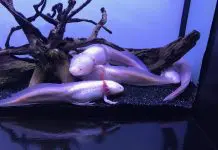

![Sick Axolotl, Fungus, Stress Symptoms [Axolotl Illness Guide 2025] Axolotl fungus](https://exopetguides.com/wp-content/uploads/2018/06/axolotl-218x150.jpg.webp)
















